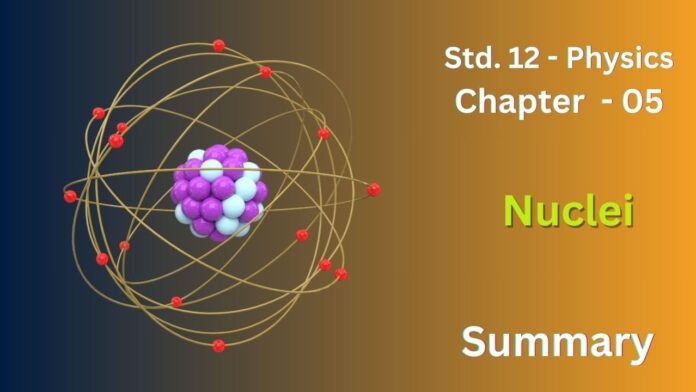The chapter “Nuclei” in the 12th standard physics part 2 NCERT textbook explores the structure, properties, and behavior of atomic nuclei. It delves into the forces holding the nucleus together, the phenomena of radioactivity, and the processes of nuclear fission and fusion.
Here’s a summary of the key concepts:
- Nuclear Composition: Nuclei are composed of protons (positively charged) and neutrons (neutral). The number of protons is the atomic number (Z), and the total number of protons and neutrons is the mass number (A). Neutrons are thus represented by N = A – Z. Nuclei are represented by the notation <sup>A</sup><sub>Z</sub>X, where X is the chemical symbol of the element. Isotopes are atoms of the same element with different numbers of neutrons. Isobars are atoms with the same mass number A, but different Z. Isotones are atoms with the same number of neutrons N, but different Z.
- Nuclear Size and Density: Nuclei are incredibly small compared to the overall size of the atom. The chapter discusses experimental evidence for determining nuclear radii. Nuclear density is remarkably constant across all nuclei.
- Nuclear Forces: The strong nuclear force is one of the four fundamental forces in nature. It is a short-range, attractive force that holds the protons and neutrons together in the nucleus, overcoming the electrostatic repulsion between the protons.
- Nuclear Binding Energy: The binding energy of a nucleus is the energy required to separate it into its constituent protons and neutrons. It is related to the mass defect, the difference between the mass of the nucleus and the sum of the masses of its individual nucleons. Einstein’s mass-energy equivalence (E=mc²) is used to calculate binding energies from mass defects. A higher binding energy per nucleon indicates a more stable nucleus.
- Radioactivity: Certain nuclei are unstable and undergo radioactive decay, emitting particles and/or energy to become more stable. The chapter discusses three types of radioactive decay:
- Alpha decay: Emission of an alpha particle (2 protons and 2 neutrons).
- Beta decay: Emission of an electron or a positron (and a neutrino or antineutrino, respectively).
- Gamma decay: Emission of high-energy photons (gamma rays).
- Radioactive Decay Law: Radioactive decay follows an exponential law. The activity of a radioactive sample decreases exponentially with time. The chapter introduces concepts like decay constant, half-life, and average life.
- Nuclear Reactions: The chapter discusses nuclear reactions, including:
- Nuclear Fission: The splitting of a heavy nucleus into two or more lighter nuclei, releasing a large amount of energy. This is the process used in nuclear power plants.
- Nuclear Fusion: The combining of light nuclei to form a heavier nucleus, also releasing a tremendous amount of energy. This is the process that powers the sun and other stars.
- Nuclear Energy: The chapter explains how nuclear fission is used in nuclear reactors to generate electricity and the potential of nuclear fusion as a future energy source.
Exercise
1. Obtain the binding energy (in MeV) of a nitrogen nucleus (N). given m (N)=14.00307 u
Ans :
1. Calculate the mass defect:
- Nitrogen has 7 protons and 7 neutrons.
- Mass of 7 protons = 7 * 1.007825 u = 7.054775 u
- Mass of 7 neutrons = 7 * 1.008665 u = 7.060655 u
- Total mass of nucleons = 7.054775 u + 7.060655 u = 14.11543 u
- Mass of Nitrogen nucleus
- = 14.00307 u
- Mass defect (Δm) = 14.11543 u – 14.00307 u = 0.11236 u
2. Convert the mass defect to energy using Einstein’s equation:
- E = mc²
- 1 u = 931.5 MeV/c²
- Binding energy (BE) = Δm * 931.5 MeV
- BE = 0.11236 u * 931.5 MeV/u
- BE ≈ 104.66 MeV
2. Obtain the binding energy of the nuclei Fe and 200 Bi in units of MeV from the following data:
m (Fe) 55.934939 u
m (20 Bi) = 208.980388 u
Ans :
1. Determine the number of protons and neutrons in each nucleus:
- Iron (Fe):
- Atomic number (Z)
- = 26 (number of protons)
- Mass number (A) = 56
- Number of neutrons (N) = A – Z = 56 – 26 = 30
- Bismuth (Bi):
- Atomic number (Z)
- = 83 (number of protons)
- Mass number (A) = 209
- Number of neutrons (N) = A – Z = 209 – 83 = 126
2. Calculate the mass defect:
- Iron (Fe):
- Mass of 26 protons = 26 * 1.007825 u = 26.20345 u
- Mass of 30 neutrons = 30 * 1.008665 u = 30.25995 u
- Total mass of nucleons = 26.20345 u + 30.25995 u = 56.4634 u
- Mass of Fe nucleus = 55.934939 u
- Mass defect (Δm) = 56.4634 u – 55.934939 u = 0.528461 u
- Bismuth (Bi):
- Mass of 83 protons = 83 * 1.007825 u = 83.649475 u
- Mass of 126 neutrons = 126 * 1008665 u = 127.09179 u
- Total mass of nucleons = 83.649475 u + 127.09179 u = 210.741265 u
- Mass of Bi nucleus = 208.980388 u
- Mass defect (Δm) = 210.741265 u – 208.980388 u = 1.760877 u
3. Convert the mass defect to energy (binding energy):
Use the conversion factor 1 u
= 931.5 MeV/c²
- Iron (Fe):
- Binding energy (BE) = 0.528461 u * 931.5 MeV/u = 492.26 MeV
- Bismuth (Bi):
- Binding energy (BE) = 1.760877 u * 931.5 MeV/u = 1640.26 MeV
Therefore:
- The binding energy of Fe is approximately 492.26 MeV.
- The binding energy of Bi is approximately 1640.26 MeV.
3.
Ans :
1. Calculate the number of atoms in the coin:
- Moles of copper:
- Molar mass of copper (Cu) = 62.92960 g/mol (given)
- Moles = mass / molar mass = 3.0 g / 62.92960 g/mol ≈ 0.04767 moles
- Number of atoms:
- Use Avogadro’s number (6.022 x 10^23 atoms/mol)
- Number of atoms = moles * Avogadro’s number = 0.04767 moles * 6.022 x 10^23 atoms/mol ≈ 2.871 x 10^22 atoms
2. Calculate the total binding energy of one copper atom:
- Protons and Neutrons in Copper-63:
- Copper-63 has 29 protons (atomic number) and 34 neutrons (63 – 29).
- Mass of individual protons and neutrons:
- Mass of 29 protons = 29 * 1.007825 u (atomic mass unit) ≈ 29.226925 u
- Mass of 34 neutrons = 34 * 1.008665 u ≈ 34.29461 u
- Total mass of individual nucleons:
- Total mass = 29.226925 u + 34.29461 u ≈ 63.521535 u
- Mass defect:
- Mass defect = (mass of individual nucleons) – (mass of Cu-63 atom) = 63.521535 u – 62.92960 u ≈ 0.591935 u
- Convert mass defect to energy (binding energy):
- Use the conversion factor 1 u ≈ 931.5 MeV
- Binding energy per atom = 0.591935 u * 931.5 MeV/u ≈ 551.4 MeV
3. Calculate the total nuclear energy for the coin:
- Total nuclear energy:
- Multiply the binding energy per atom by the number of atoms in the coin.
- Total energy = 551.4 MeV/atom * 2.871 x 10^22 atoms ≈ 1.583 x 10^25 MeV
4. Convert to Joules (optional):
- Convert MeV to Joules:
- 1 MeV = 1.602 x 10^-13 J
- Total energy in Joules = 1.583 x 10^25 MeV * 1.602 x 10^-13 J/MeV ≈ 2.536 x 10^12 J
Final Answer:
The nuclear energy required to separate all the neutrons and protons in the coin is approximately 1.583 x 10^25 MeV or 2.536 x 10^12 Joules.
4.
Ans :
The radius of a nucleus is related to its mass number (A) by the following empirical formula:
R = R₀ * A^(1/3)
where:
- R is the radius of the nucleus
- R₀ is a constant (approximately 1.2 x 10^-15 meters or 1.2 fermi)
- A is the mass number
Given Information
- Gold (Au) isotope: A = 197
- Silver (Ag) isotope: A = 107
Calculations
- Radius of Gold (Au): R_Au = R₀ * (197)^(1/3)
- Radius of Silver (Ag): R_Ag = R₀ * (107)^(1/3)
- Ratio of Radii: (R_Au / R_Ag) = (R₀ * (197)^(1/3)) / (R₀ * (107)^(1/3))
Notice that R₀ cancels out:
(R_Au / R_Ag) = (197/107)^(1/3) - Calculate the Ratio: (R_Au / R_Ag) ≈ (1.841121495)^(1/3) (R_Au / R_Ag) ≈ 1.225
5.
Ans :
Given Data
- m(¹₂H) = 2.014102 u
- m(¹₃H) = 3.016049 u
- m(¹²₆C) = 12.000000 u
- m(²⁰₁₀Ne) = 19.992439 u
- m(⁴₂He) = 4.002603 u (You’ll need this value, which isn’t in the image)
Conversion Factor
- 1 u = 931.5 MeV/c²
Calculations
(i) ¹₁H + ¹₃H → ¹₂H + ¹₂H
- Mass of reactants: m(¹₁H) + m(¹₃H) = 1.007825 u + 3.016049 u = 4.023874 u (We use the atomic mass of ¹H which is 1.007825 u)
- Mass of products: m(¹₂H) + m(¹₂H) = 2.014102 u + 2.014102 u = 4.028204 u
- Mass difference: Δm = (mass of reactants) – (mass of products)
Δm = 4.023874 u – 4.028204 u = -0.00433 u
- Q-value: Q = Δm * 931.5 MeV/u Q = -0.00433 u * 931.5 MeV/u ≈ -4.03 MeV
Since Q < 0, this reaction is endothermic.
(ii) ¹²₆C + ¹²₆C → ²⁰₁₀Ne + ⁴₂He
- Mass of reactants: m(¹²₆C) + m(¹²₆C) = 12.000000 u + 12.000000 u = 24.000000 u
- Mass of products: m(²⁰₁₀Ne) + m(⁴₂He) = 19.992439 u + 4.002603 u = 23.995042 u
- Mass difference: Δm = (mass of reactants) – (mass of products)
Δm = 24.000000 u – 23.995042 u = 0.004958 u
- Q-value: Q = Δm * 931.5 MeV/u Q = 0.004958 u * 931.5 MeV/u ≈ 4.62 MeV
Since Q > 0, this reaction is exothermic.
(i) ¹₁H + ¹₃H → ¹₂H + ¹₂H:
- Q ≈ -4.03 MeV
- Endothermic
(ii) ¹²₆C + ¹²₆C → ²⁰₁₀Ne + ⁴₂He:
- Q ≈ 4.62 MeV
- Exothermic
6.
Ans :
1. Write the Nuclear Reaction:
⁵⁶Fe → ²⁸Al + ²⁸Al
2. Calculate the Mass Defect (Δm):
- Mass of reactants: m(⁵⁶Fe) = 55.93494 u (given)
- Mass of products: 2 * m(²⁸Al) = 2 * 27.98191 u = 55.96382 u
- Mass defect (Δm) = Mass of reactants – Mass of products
- Δm = 55.93494 u – 55.96382 u = -0.02888 u
3. Convert Mass Defect to Energy (Q):
- Use the conversion factor 1 u
- = 931.5 MeV/c²
- Q = Δm * 931.5 MeV/c² Q = -0.02888 u * 931.5 MeV/c² Q ≈ -26.9 MeV
4. Analyze the Result:
- Q < 0: The Q-value is negative, which means the reaction is endothermic.
7.
Ans :
8.
Ans :
1. Calculate the number of deuterium nuclei in 2.0 kg:
- Moles of deuterium:
- Molar mass of deuterium (²H) = 2.014 g/mol (approximately)
- Moles = mass / molar mass = 2000 g / 2.014 g/mol ≈ 993.05 moles
- Number of deuterium nuclei:
- Use Avogadro’s number (6.022 x 10^23 nuclei/mol)
- Number of nuclei = moles * Avogadro’s number = 993.05 moles * 6.022 x 10^23 nuclei/mol ≈ 5.979 x 10^26 nuclei
2. Calculate the total energy released from fusion:
- Energy per fusion reaction:
- 3.27 MeV (given)
- Total energy from all nuclei:
- Total energy = (number of nuclei / 2) * energy per reaction = (5.979 x 10^26 nuclei / 2) * 3.27 MeV/reaction ≈ 9.776 x 10^26 MeV
- Convert MeV to Joules:
- 1 MeV = 1.602 x 10^-13 J
- Total energy in Joules = 9.776 x 10^26 MeV * 1.602 x 10^-13 J/MeV ≈ 1.566 x 10^14 J
3. Calculate the time the lamp can be kept glowing:
- Power of the lamp:
- 100 W (given) (Watts = Joules per second)
- Time:
- Time = Total energy / Power = 1.566 x 10^14 J / 100 J/s ≈ 1.566 x 10^12 seconds
4. Convert seconds to a more understandable unit (e.g., years):
- Seconds to years:
- 1 year ≈ 3.154 x 10^7 seconds
- Time in years = 1.566 x 10^12 seconds / 3.154 x 10^7 seconds/year ≈ 49,650 years
9. Calculate the height of the potential barrier for a head on collision of two deuterons. (Hint: The height of the potential barrier is given by the Coulomb repulsion between the two deuterons when they just touch each other. Assume that they can be taken as hard spheres of radius 2.0 fm.)
Ans :
U = (k * q₁ * q₂) / r
3. Apply to Deuterons
- Each deuteron has a charge of +e, where e is the elementary charge (approximately 1.602 × 10⁻¹⁹ C).
- When the deuterons just touch, the distance between their centers is twice their radius (2r).
- The radius (r) is given as 2.0 fm = 2.0 × 10⁻¹⁵ m.
4. Calculate the Potential Energy
U = (k * e * e) / (2r)
U = (8.98755 × 10⁹ N⋅m²/C² * (1.602 × 10⁻¹⁹ C)²) / (2 * 2.0 × 10⁻¹⁵ m)
U ≈ 5.77 × 10⁻¹⁴ J
5. Convert to MeV
It’s common to express this energy in mega-electron volts (MeV). Use the conversion factor 1 MeV = 1.602 × 10⁻¹³ J.
U ≈ (5.77 × 10⁻¹⁴ J) / (1.602 × 10⁻¹³ J/MeV)
U ≈ 0.36 MeV
10.
Ans :


